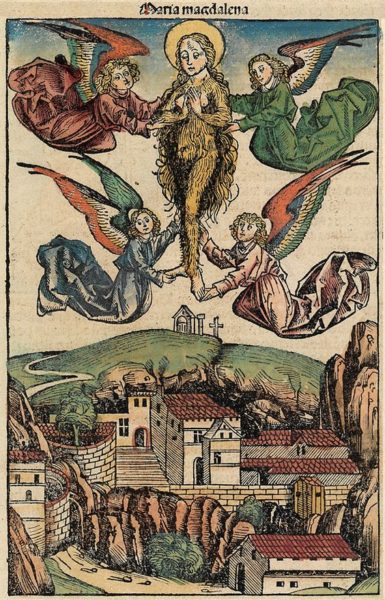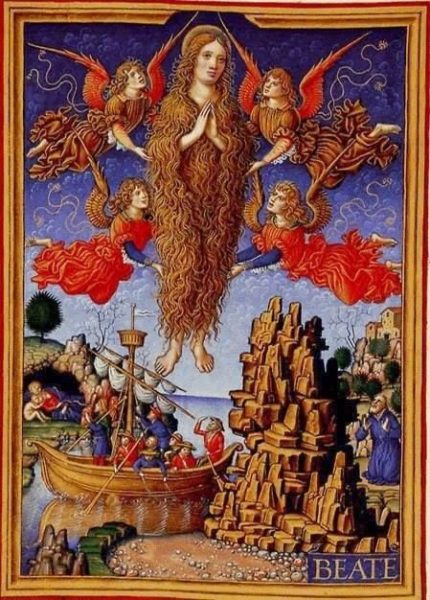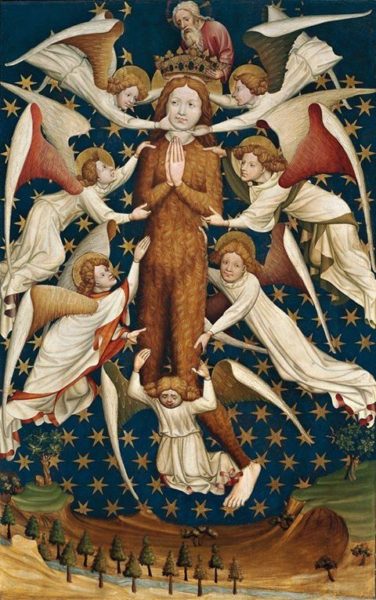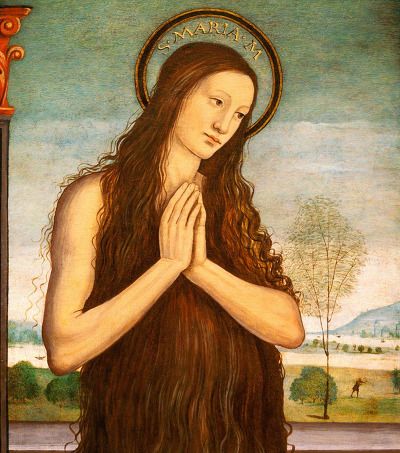 Last updated: March 14, 2024
Last updated: March 14, 2024
As I mentioned in a previous blog post, I have been collecting art images of Mary Magdalene for a long time. It all began years ago when I was looking on the internet for a few images to use in my Mary Magdalene feast day celebrations. It was interesting to see how she was almost always clothed in accordance with the upscale fashion of the times and the location of the artist.
In the Middle Ages, it was common to simplify the art to appeal to and educate viewers, many of whom did not know how to read. For this reason, an iconography of Mary Magdalene developed, where she is often depicted with long red hair and an alabaster jar with oil. In the art history world, these are called her attributes – most other saints have attributes as well, so that they can be instantly recognized.
 However, now with the explosion of art images that are instantly available, I have over 1200 images of MM on my Pinterest board Mary Magdalene (that you should follow by the way.) I am somehow surprised there are so many, but even this number is low I think, partly because I tend not to pin the extremely penitential Magdalenes pondering skulls.
However, now with the explosion of art images that are instantly available, I have over 1200 images of MM on my Pinterest board Mary Magdalene (that you should follow by the way.) I am somehow surprised there are so many, but even this number is low I think, partly because I tend not to pin the extremely penitential Magdalenes pondering skulls.
In any case, I started finding images of MM where she was naked, clothed only in her long red hair. Perhaps stubbornly, I was hoping that these strange images weren’t depicting her this way due to the mistaken idea that she was a prostitute. Yes?
In the meantime, I started stumbling across similar images of Mary of Egypt, who I had never heard of before. Many of the images I collected on my Pinterest board Mary of Egypt show her clothed only in her long hair. Mostly she has silver hair of various lengths and looks like an emaciated lunatic, so how should we approach these images? To answer that question, I started looking at the images I had collected on these saints, in order to see what might be going on with the iconography that seemed to connect these two women.
Turns out that Mary of Egypt was a reformed prostitute (but you already knew that right?) If not, you can read her story in my blog post here. In a similar manner, MM has been pegged as a reformed prostitute who was conflated with the unnamed woman who anointed Jesus. Matthew, Mark, and John also tell the story, but it is in Luke 7:36-50 where, depending on the translation, she is named as “a notorious sinner” or “a certain immoral woman,” or “a woman who had a  low reputation” or “a woman who lived a sinful life” or “a woman of the city,” all of which have led some people to conclude that she was a prostitute. So, it seems that Mary Magdalene may also have been conflated in art with Mary of Egypt, who according to her legend lived in the desert so long that her clothes disintegrated.
low reputation” or “a woman who lived a sinful life” or “a woman of the city,” all of which have led some people to conclude that she was a prostitute. So, it seems that Mary Magdalene may also have been conflated in art with Mary of Egypt, who according to her legend lived in the desert so long that her clothes disintegrated.
One interesting thing about these hairy Mary art images is that many appear to depict an assumption event, where she is being carried aloft by angels. Church tradition says that the body of Mary, mother of Jesus was assumed into heaven, but I was unaware that there was this somewhat obscure visual tradition of MM also being assumed into heaven. You can find more images of the assumption of MM at Wikimedia Commons here. or at my Hairy Mary Pinterest section here.
 And – if you look at artwork that features the assumption of Mary, mother of Jesus, you will notice that the iconography is very similar to the images above – being carried aloft by angels. Without the naked part…. Here is a link to the 2011 blog post at the Ad Imaginem Dei website that gives numerous examples of art depicting the death and assumption of Mary, mother of Jesus.
And – if you look at artwork that features the assumption of Mary, mother of Jesus, you will notice that the iconography is very similar to the images above – being carried aloft by angels. Without the naked part…. Here is a link to the 2011 blog post at the Ad Imaginem Dei website that gives numerous examples of art depicting the death and assumption of Mary, mother of Jesus.
When I first found the hairy Mary Magdalene images, I was astonished to find that the hair in some places looks like fur that is growing directly out of her skin. This is also seen in some of the Mary of Egypt images. I found an interesting website of a Polish art historian, Magdalena Lanuszka, who is familiar with these images.
In her 2014 blog post, she associated these images of a naked, but hairy Mary Magdalene with the legend that she became a hermit in a cave in Provence, France. In this way, Lanuszka originally connected these Mary Magdalene images to those of the fourth century hermit, Mary of Egypt, whose clothes wore out and turned to dust over the many years she lived in the desert. So yes, I guess in the end, this is all about reformed prostitutes. The conflation of these two women named Mary makes sense to me, based on my review of all of the images that I have collected.
 However, in her 2018 blog post, Lanuszka revisits her thinking by noting the hairy fur and drawing parallels to medieval “Wild Man” and “Wild Woman” images. She notices that in some hairy images, MM’s feet, knees and breasts were not covered in hair. This is key to her suggestion that a hairy Mary Magdalene was being compared with a Wild Woman. There is a body of artwork from the Middle Ages, sometimes located in the margins of illuminated manuscripts, that showcases men and women as hairy beasts living in the wilderness. I have found such images too, and so I am inclined to agree that this interpretation may be a piece of the iconographic puzzle.
However, in her 2018 blog post, Lanuszka revisits her thinking by noting the hairy fur and drawing parallels to medieval “Wild Man” and “Wild Woman” images. She notices that in some hairy images, MM’s feet, knees and breasts were not covered in hair. This is key to her suggestion that a hairy Mary Magdalene was being compared with a Wild Woman. There is a body of artwork from the Middle Ages, sometimes located in the margins of illuminated manuscripts, that showcases men and women as hairy beasts living in the wilderness. I have found such images too, and so I am inclined to agree that this interpretation may be a piece of the iconographic puzzle.
If you enjoyed this blog post, you might be interested in my February 27, 2024 blog post about a recently unveiled hairy Mary Magdalene image and the story of a blue tunic relic from Hungary.
UPDATES: This blog post was updated on August 9, 2023 and again on September 5, 2023 to include additional images of Mary Magdalene, to update links, and to make small editorial changes. This blog post was updated on March 14, 2024 to include a link to a more recent blog post called Mary Magdalene and the Blue Tunic Relic.

Reference 1: “Imagery of Ascension of Mary Magdalene,” blog post by Artelisa, July 15, 2013 at http://artelisaart.blogspot.com.
Reference 2: “Mary is Assumed into Heaven,” blog post at Ad Imaginem Dei, August 15, 2011 at http://imaginemdei.blogspot.com.
Reference 3: “The Assumption of the Virgin Mary – The Story of the Virgin’s Belt,” blog post at Ad Imaginem Dei, August 14, 2020 at http://imaginemdei.blogspot.com.
Reference 4: “Hairy Mary,” blog post by Magdalena Lanuszka, July 19, 2014 at http://en.posztukiwania.pl/2014/07/19/hairy-mary/.
 Reference 5: “Hairy Mary – One More Time,” blog post by Magdalena Lanuszka, November 10, 2018 at http://en.posztukiwania.pl/2018/11/10/hairy-mary-one-more-time/.
Reference 5: “Hairy Mary – One More Time,” blog post by Magdalena Lanuszka, November 10, 2018 at http://en.posztukiwania.pl/2018/11/10/hairy-mary-one-more-time/.
Image 1: Illustration from Nuremberg Chronicle, illustrated by Michael Wolgemut and Wilhelm Pleydenwurff, text by Hartmann Schedel, 1493, Wikimedia Commons, public domain.
Image 2: “The Ascension of Mary Magdalene” by Antonio Vivarini, Italy, circa 1440-1480, Wikimedia Commons, public domain.
Image 3: “St. Mary Magdalene” by Giovanni Pietro Birago, Sforza Hours, British Library, MS 34294, fol.211.v, circa 1490, Wikimedia Commons, public domain.
Image 4: “Ascension of Mary Magdalene,” by anonymous painter from Gdansk, tempera on panel, circa 1430, National Museum in Warsaw, Poland, Wikimedia Commons, public domain.
Image 5: “St. Mary Magdalene,” by Magdalena Pseudo Granacci, circa 1510, Tempera on panel, 49.5 x 41 cm, Bowdoin College Museum of Art, Brunswick, Maine.
Image 6: “M Ms Ascension,” Mary Magdalene altar cabinet, late 15th century, Medeltidens bildvarld, from Harad in Sodermanland, Sweden.
Image 7: Illustration of Mary Magdalene by the Dunois Master from illuminated Book of Hours, ff 291, circa 1440-1450, currently in collection at the British Library.















6 Comments
Leave your reply.